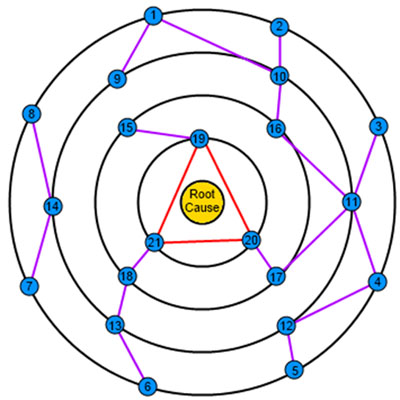Over at Gnome Stew, Patrick Benson has proposed the “Orbital Path Method of Plot Design“. I know I’ve said in the past that you should never prep a plot, but you might want to check this out because I think it has some conceptually useful stuff for node-based scenario design. Here’s the gist of it:
Using my terminology, each of those numbered dots is a node and you can follow any line from one node to another. So, for example, node 6 would have links to nodes 5, 7, and 13. Benson says that the “kicker” for the campaign should introduce several of the nodes in the outer ring and then play would proceed from there.
From a conceptual standpoint, what I find useful here is the visualization of escalation: As you move closer and closer to what Benson describes as the “root cause”, the stakes or difficulty or intensity or whatever increases.
I think this approach has a few practical problems: Like most diagrammatic approaches, it tends to artificially constrict navigational paths. The lack of backwards motion within the design scheme may tend to leave a lot of “abandoned” nodes in the players’ wake. That, combined with the seeming preference for a large number of “outer” nodes and a lower number of “inner” nodes will probably result in a lot of wasted prep.
Despite that, I thought it was a really interesting approach to visualizing the relationships between nodes. Check it out.














Thanks for sharing my article! I think that your insights are spot on. I did not mention it in the article, but I allow for the story to move from an inner ring to an outer one. The intensity drops, but more minor details and leads are revealed. With some games that won’t work, but with the systems I play they tend to be just fine and it adds a nice “trail is hot/trail is cold” aspect.
Also, consider that you can find the other encounters on the same orbit, even if they are not explicitly connected. This might happen as a result of exploring a level deeper, gleaning a few bits of information, and getting sidetracked, or it could happen as a result of them stumbling on these other encounters. Seems like a pretty interesting idea, though. Might be interesting to look at some plotted adventures, and see how they would fit into a design like this? Might get boring after a few.
Yeah to me I think that if you just draw a lot more lines on the diagram you have a perfectly awesome way of visualizing a perfectly awesome node-based adventure.
I am a bit wary that the outer ring will wind up under-utilized in play in relation to its possible prep time so when I use this framework (as I intend to) I’ll keep the outer ring of nodes very simple and devote proportionally much less prep time to them than to the inner nodes–and I’ll probably make it so that the players are strongly encouraged (and rewarded) for orbital movement as opposed to diving straight into the middle as fast as possible.